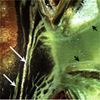Grapes 101 is a series of brief articles focused on the basics of viticulture and enology, and published in Appellation Cornell, a quarterly newsletter from Cornell’s Viticulture and Enology Program.
Several articles focus on the basics of how vines grow and how their tissues are organized. Here is a collection of articles focused on vine anatomy and physiology:
 Resource Assimilation and Vineyard Productivity
Resource Assimilation and Vineyard Productivity
Viticulture is about capturing sunlight and soil nutrients and converting them into organic compounds for fuel and growth.
 Sources and Sinks: Allocation of Photosynthates during the Growing Season
Sources and Sinks: Allocation of Photosynthates during the Growing Season
Carbon produced through photosynthesis is allocated to different tissues at different times in the growing season.
 How Grapevine Buds Gain and Lose Cold-hardiness
How Grapevine Buds Gain and Lose Cold-hardiness
Each year buds transition from a cold-tender to cold-hardy state through a gradual process that starts around veraison and continues through the winter.
 How Grapevines Reconnect in the Spring
How Grapevines Reconnect in the Spring
In midwinter, buds are isolated from the rest of the vine’s vascular system. Signals from the buds reactivate the vine’s vascular cambium, reconnecting shoots, trunks, and roots – a process starting at budswell and ending at bloom.
